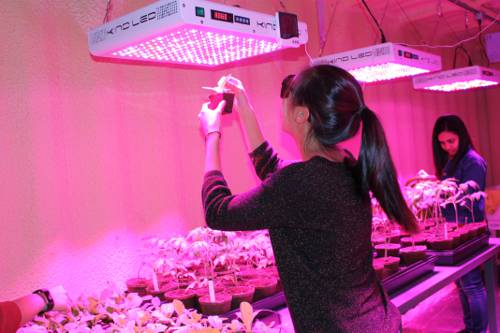
FAQ About Indoor Plant LED Growth Spectrums

What is an LED light spectrum and why is it important for indoor plant growth?
An LED light spectrum refers to the range of light wavelengths emitted by an LED grow light. It is crucial for indoor plant growth because different wavelengths affect various growth stages such as germination, vegetative development, and flowering.
Plants primarily use red and blue wavelengths, with red light promoting flowering and blue light encouraging foliage growth. Understanding and utilizing the correct spectrum can significantly enhance plant health and productivity indoors.

What are the benefits of using LED lights for indoor plants compared to other types of grow lights?
LED lights offer several benefits compared to other types of grow lights, such as high-intensity discharge (HID) or fluorescent lights. They are more energy-efficient, which lowers electricity bills and reduces the carbon footprint. LED lights also generate less heat, minimizing the risk of burning plants and reducing cooling costs.
Additionally, LEDs provide a precise and adjustable light spectrum tailored to different growth phases, ensuring optimal plant development. Their longevity and durability further make them a cost-effective choice for indoor gardening.

How does the blue light spectrum affect indoor plants?
Blue light is crucial for the vegetative growth stage of indoor plants. It helps promote strong, healthy leaf and stem development by regulating growth processes like photosynthesis and chlorophyll production.
By using blue light, growers can ensure their plants develop the lush foliage necessary for healthy growth and prepare them for the flowering phase if applicable.

What role does red light play in the growth of indoor plants?
Red light plays a significant role in the flowering phase of plant growth. It encourages flowering and fruiting by affecting the photoperiodic processes that regulate these stages.
Optimizing the red light spectrum can enhance the quantity and quality of flowers or fruits produced, making it a critical component for indoor growers aiming for high yields at these stages.

Can using the wrong LED light spectrum harm indoor plants?
Yes, using an incorrect LED light spectrum can adversely affect indoor plants. A mismatch in light spectrum can lead to inadequate plant growth; for example, excessive red light can result in leggy plants, while too much blue light might cause plants to become stunted.
It's necessary to select the appropriate spectrum tailored to specific growth stages and plant types to avoid growth deficiencies and ensure healthy plant development.

What is the full spectrum LED light and how does it benefit plant growth?
Full spectrum LED lights mimic natural sunlight by providing a balanced range of all the essential wavelengths for plant growth, including red, blue, and other less prominent spectra. They support all stages of plant development, from germination to flowering.
Using full spectrum LEDs can simplify the lighting setup for growers, making it ideal for those cultivating a variety of plant types and needing a versatile solution for sustained plant health.

How does the spectrum need change from seedling to flowering stages?
During the seedling and vegetative stages, plants typically require more blue light, which encourages robust leaf and stem development. As plants transition to the flowering stage, they benefit from an increase in red light, fostering the production of flowers and fruits.
Adjusting the light spectrum in response to these growth stages can optimize plant health and yield.

Are there any specific LED light spectrums recommended for different plant types?
Different plant types may have varying light spectrum preferences due to their unique growth requirements. For example, leafy greens often thrive under higher blue light content, promoting healthy leaves and stems.
Conversely, flowering plants such as tomatoes and marijuana may require a higher proportion of red light to enhance their flowering and fruiting. Customized spectrum solutions can help achieve the desired growth results for specific plants.

What is the difference between PAR and PUR in the context of LED grow lights?
PAR (Photosynthetically Active Radiation) refers to the range of light wavelengths (400-700 nm) that plants use for photosynthesis. PUR (Photosynthetically Usable Radiation) is a subset of PAR that plants can directly utilize more efficiently.
While PAR covers the potential usable light, PUR focuses on the quality of the light specific to plant needs, which is essential for optimizing the LED spectrum's effectiveness for growth.

How often should LED light spectrums be adjusted for optimal plant growth?
LED light spectrum adjustments should align with the plant's growth stages. Initially, during germination and early vegetative stages, more blue light is optimal. As plants shift into flowering stages, increasing red light in the spectrum is beneficial.
Monitoring plant health and growth patterns regularly and adjusting the light spectrum accordingly will ensure the plants thrive throughout their lifecycle.

Why are LED grow lights preferred over fluorescent lights for indoor plants?
LED grow lights are preferred over fluorescent lights due to their superior energy efficiency, longer lifespan, and customizable spectrum. They consume less power, generating less heat, which helps to maintain a stable growing environment and reduces cooling expenses.
Moreover, the ability to fine-tune the LED light spectrum to cater to various plant growth stages and types makes them more versatile and effective for indoor gardening compared to traditional fluorescent options.

What does a 'balanced' LED spectrum mean for indoor plant growth?
A 'balanced' LED spectrum refers to a light composition that evenly supports all phases of plant growth by including both primary (red and blue) and secondary (green, far-red, UV) wavelengths.
This balanced approach ensures plants receive the necessary light for a full range of biological processes, from photosynthesis to flowering, improving overall growth results.

Can LED grow lights be used for all kinds of indoor plants?
Yes, LED grow lights can be used for all kinds of indoor plants. Due to their customizable spectrum, they can accommodate the specific light needs of a wide variety of plants, from low-light-tolerant houseplants to high-light-requiring flowering or fruiting species.
Using LED grow lights tailored to the specific requirements of different plant types and growth stages ensures optimal plant health and efficiency.

How long do LED grow lights need to be on for optimal plant growth?
The duration that LED grow lights should be on varies depending on the plant type and its growth stage. Generally, most plants require 12-16 hours of light daily during their vegetative stage, and 8-12 hours during the flowering stage.
It's essential to replicate the natural light cycles of the plants' original environments to ensure proper growth and development.

What is the significance of UV and IR light in LED growth spectrums?
UV (ultraviolet) and IR (infrared) light play supportive roles in plant growth. UV light can stimulate hormone pathways in plants, potentially enhancing flavor, color, and disease resistance.
IR light is associated with ensuring proper stem elongation and flowering. While not as critical as red or blue light, they can contribute to healthier and more productive plants when used correctly within the spectrum.

What are some common misconceptions about LED grow lights for plants?
One common misconception is that LED grow lights can instantly improve plant growth without proper spectrum adjustment. In reality, correct spectrum tuning aligned with plant needs is crucial.
Another myth is that more powerful lights always equate to better growth, whereas excessive light intensity can harm plants. Understanding plant-specific requirements and how to adjust light spectrums is key to leveraging LED grow lights successfully.

How do dimmable LED grow lights contribute to plant growth management?
Dimmable LED grow lights allow growers to control the light intensity, which can help better match the light requirements of various growth stages without switching the whole light setup.
This flexibility can prevent stress to plants from excessive light exposure and enables gradual adjustments that accommodate natural growth patterns and seasonal changes in plant needs.

Is there a universal LED light spectrum for all indoor plants?
There isn't a single universal LED light spectrum effective for all indoor plants due to their diverse needs. While full spectrum LEDs provide a general solution by covering a wide range of wavelengths, specific plant types and growth phases may still require tailored spectrum adjustments.
Successful indoor cultivation involves matching LED light spectrums with specific plant demands to maximize health and productivity.

Do all LED grow lights have the same lifespan?
While most LED grow lights are known for long lifespans compared to other grow lights, not all are the same. The lifespan can vary based on the quality of the LED chips, the design of the fixture, and how they are used (like heat management and environmental conditions).
High-quality LEDs from reputable manufacturers typically last longer and maintain consistent performance over time.

How can the effectiveness of LED grow light spectrums be measured?
The effectiveness of LED grow light spectrums can be measured through plant growth outcomes such as height, leaf area, flowering time, and yield. More technically, spectroradiometers can measure the precise wavelength output to ensure spectrums align with the plant's needs.
Regular observation, combined with appropriate adjustments based on plant response, contributes to gauging and optimizing LED light spectrum effectiveness.
